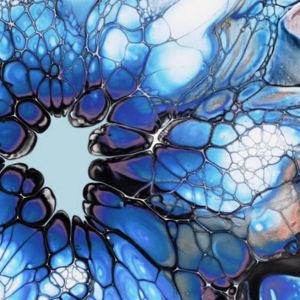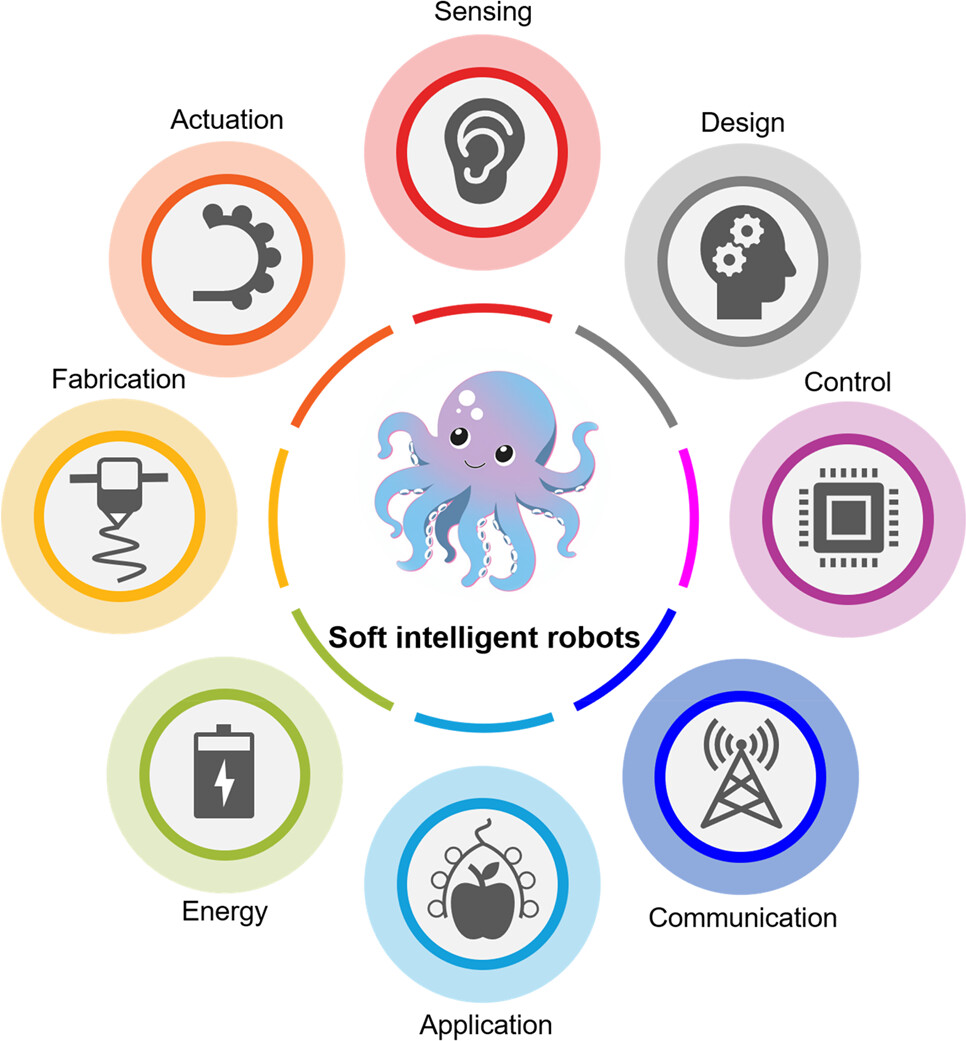9. Soft robotics¶
References & Inspirations¶

Soft, squishy, squeezable. These aren’t words usually associated with robots. The goal of soft robotics is the design and construction of robots with physically flexible bodies and electronics.


image credits
from left to right:
-
SFX Makeup by Tomo Hyakutake
-
Skeleton inflatable bomber jacket, FW'23 by Walter Van Beirendonck
-
Stellapluma, kinetic wearable by Casey Curran
Social soft robotics may provide a new solution for alleviating human pain and fear. Soft robotics with actuation functions can achieve therapeutic effects by doing external work. Researchers from the University of Tsukuba measure indicators of stress and fear during simulated medical treatments, and find that using a wearable soft robot can improve patient's experience. The soft, fur-covered robot the scientists called Reliebo was designed to be attached to the participant's hand; it contained small airbags that could inflate in response to hand movements and relax the patient. Another inspirational project is this arm-stroking wearable found to reduce perceived stress and anxiety.
weekly assignment
the assignment is to:
-
make a soft robotic sample, develop the pattern for the Inflatable and draw a sketch of the air flow
-
experiment with different materials, such as: silicones, 3d printing, parchment paper, thermoadesive vynil, TPU fabrics
-
build a Soft Gripper
-
build a Pneumatic Wrist brace
-
build and document a Pneumatic, digitally controlled system, electronics schematic, electronic control and code
soft robotics resources
inspirational projects
- Kyon
- Adriana Cabrera
- Saskia Helinska Fabricademy 2022 - Final Project
- Marisa Stasia Fabricademy 2022
- Loes Bogers Fabricademy 2020
- Ieva Dautartaite Fabricademy 2023
- Vicky Luan Fabricademy 2022
Research¶
Living organisms depend on real-time and stored information to react, while soft robotics often suffer from nontrivial integration with actuators, sensors, and controllers. To achieve perception in soft robotics, important issues must be taken into account regarding the development of soft actuators, stretchable sensors, and embedded electronics. Soft Robotics and Programmable Materials are subdomains of Human-Computer Interaction - HCI - and they are complex topics. Fortunatly there is a variety of studies and sources of information to look for. During my research I came across with terms and fields of study that I consider relevant for the construction of a soft robot, so I look up about:
-
BIOROBOTICS: robots that incorporate features or behaviors found in biological organisms. Also known as bio-inspired or biomimetic robots.
-
ELECTRICPOP: is project based on a low-cost, shape-Changing displays using electrostatically inflated mylar sheets.
-
EMBODIEMENT INTERACTION: describes the interplay between the brain and the body and its influence on the sharing, creation and manipulation of meaningful interactions with technology. They have the potential to amplify human interaction and communication capacities.
-
HAPTIC FEEDBACK: also known as tactile feedback, is a technology that provides users with physical sensations or vibrations in response to their interactions with a device or interface. It enhances user experiences by adding a sense of touch to digital interactions. SleeveIO is a modular and reconfigurable hardware platform for rapid prototyping of multimodal wearable haptic feedback interactions.Types of Haptic Feedback includes: basic vibration, texture simulation and force. feedback, tactile patterns.
-
KINEMATICS: equations that describe how objects move. Can be applied to just about anything, including robotics. It doesn’t take into account forces causing the objects to move, because then it’s called dynamics. It is often used in the context of physics, where kinetic energy refers to the energy of motion.
-
MILIMORPH: it's a fabrication system of creating fluidic chambers and channels at millimeter scale for tangible actuated interfaces. It allows to create high frequency actuation, sequential control of flows and high resolution design on thin film materials with a novel heat sealing system.
-
OFF-LINE SENSING: are passive 3D-printed sensors that detect one-time interactions, such as accelerating or flipping, but neither requires active electronics nor power at the time of the interaction. They memorize a pre-defined interaction via an embedded structure filled with a conductive medium (e.g., a liquid).
-
OMNIFIBER:is a soft, line-based material system for designing movement-based interactions
-
PROPRIOCEPTION: refers to sensory inputs that principally regulate motor control, such as inputs that signal muscle stretch and tension.
-
PNEUDUINO:is a hardware platform for controlling air flow and pressure for their projects. It is developed by Felix Heibeck, Jifei Ou at MIT Media Lab, Tangible Media Group.
-
SMA: aka shape memory aloy are metals, which exhibit two very unique properties, pseudo-elasticity, and the shape memory effect. They're capable of transforming thermal energy into mechanical work. If the heating and cooling of these alloys is controlled by pulsed direct electrical current, repeated cyclic motions can be achieved and used in robotic applications as thermal-mechanical actuators. Learn how to make a SMA muscle here
-
VENOUS MATERIALS: is a novel concept and approach of an interactive material utilizing fluidic channels made by Hila Mor
- WEARABLE ROBOTS: are a specific type of wearable device that is used to enhance a person's motion and/or physical abilities. They are also known as bionic robots or exoskeletons.

This figure highlights the key components essential for constructing a smart soft robot, including actuation, sensing, and energy/fuel for operation, as well as electronics for control and communication. Additionally, important considerations such as the fabrication method, design, control algorithms, and application aspects are depicted.
Heat Sealing Inflatables¶
https://dl.acm.org/doi/10.1145/3430524.3442457
This is DIY method of creating inflatables and prototyping interactive materials from wasted thermoplastic bags. I used a 3D printer, without any customization of the printer, to heat-seal and patterning different types of mono and multilayered thermoplastic bags. This tutorial can be found at MIT Media Lab.
Silicone Inflatables¶
Soft Gripper¶
Step 1 - Mold Housing Design¶
The project requires access to a 3D printer, or you can order a 3D printed mold from an online printing service like Shapeways, Sculpteo or iMaterialise. I chose to use a STL file [^1] for this basic four-leg gripper. This model is also available on Cults and Thingiverse. If you chose to draw it yourself you can use a free 3D Modeling Software like: SketchUp, Thinkercad, Vectary or Autodesk Meshmixer
Step 2 - 3D Printing Mold¶
By this point, it’s important you have a part ready to print and you have chosen your material. Before you start printing, you need to translate your design into ‘coordinates’ the 3D printer can understand, as well as tell it parameters such as the material you are printing with. This is known as ‘slicing’, because it involves slicing the 3D design into layers. This is typically done in a program known as slicing or print preparation software. Ultimaker Cura software comes with many preconfigured settings. Once the slicing is done, your GCode [^2] file is ready to print. Before you start printing, be sure to check you have the right material loaded. You can find more support here.



Tools¶
- Slicing Software: Ultimaker Cura
- 3D Printer: Creality Ender 6
- PLA Recycled Filament: by Real Filament white 1.75mm
Step 3 - Mold Casting & Unmolding¶
Ecoflex comes in two bottles, containing Part A and Part B. Parts A and B are liquids - when mixed together, they will solidify and form silicone rubber. The materials are non-toxic, and harmless once cured.If you do get Part A or B on your skin, just wash it off with soap and water.
Mold Casting workflow de Lia Von F.
Tools¶
- Ecoflex 00-10: Part A 20ml + Part B 20ml
- Disposable rubber gloves
- Plastic or glass measuring cups
- Non stretch fabric sample (aluminium foil is optional)
- Rigid or metal tray
- Plastic or metal stick
- Mold Housing (9,4 x 9,4cm)
Bubble Wrist Band¶
The mold to make this softrobot consists of two parts, one part is the one that has the air channels and the other part is the one that closes the open part of the channel.
Step 1 - Mold Housing Design¶
This pattern was designed to create a texture of inflatable bubbles. The laser cut nesting design [^3] was made by Monserrat.
Step 2 - Laser Cut Mold¶
There are a few tips you can follow that can ensure your laser cutting accuracy. First, you must choose materials that your machine can effectively fabricate. Second, ensure that you adjust your laser cutting power and laser settings correctly adjusted for your specified project and material. Finally, make sure you correctly secure the workpiece to the workbed. A workpiece that moves around, even slightly, because it is not secure and on a stable surface can create undesirable results.
Tools¶
- Vector Graphics Editor Software: LightBurn
- Laser Cut machine: Creality Ender 6
- Cast acrylic: white, 5mm thickness, 40x30 cm sheet
footnote fabrication files
Fabrication files are a necessary element for evaluation. You can add the fabrication files at the bottom of the page and simply link them as a footnote. This was your work stays organised and files will be all together at the bottom of the page. Footnotes are created using [ ^ 1 ] (without spaces, and referenced as you see at the last chapter of this page) You can reference the fabrication files to multiple places on your page as you see for footnote nr. 2 also present in the Gallery.

This schematic [^4] was obtained by..
This tutorial [^5] was created using..
footnote fabrication files
Fabrication files are a necessary element for evaluation. You can add the fabrication files at the bottom of the page and simply link them as a footnote. This was your work stays organised and files will be all together at the bottom of the page. Footnotes are created using [ ^ 1 ] (without spaces, and referenced as you see at the last chapter of this page) You can reference the fabrication files to multiple places on your page as you see for footnote nr. 2 also present in the Gallery.
---¶
---¶
Fabrication files¶
^1 File: Soft Gripper.STL
^2 File: Soft Gripper.GCode
^3 File: Bubbles.PDF